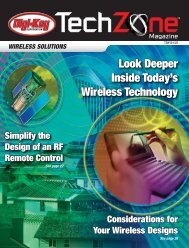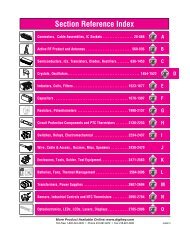Microcontroller Solutions TechZone Magazine, April 2011 - Digikey
Microcontroller Solutions TechZone Magazine, April 2011 - Digikey
Microcontroller Solutions TechZone Magazine, April 2011 - Digikey
You also want an ePaper? Increase the reach of your titles
YUMPU automatically turns print PDFs into web optimized ePapers that Google loves.
USB 3.0 is clearly overkill for HID applications, but it’s definitely a<br />
new contender for embedded CDC and MSC applications, particularly<br />
those involving streaming high-definition video. Its power advantage<br />
over legacy USB makes it a serious consideration for portable devices.<br />
Architectural innovations<br />
Achieving a 10x speed improvement while reducing power<br />
consumption involved making serious architectural changes to both<br />
the protocol and associated hardware. At the same time, some tradeoffs<br />
(and clever workarounds) were necessary to maintain backward<br />
compatibility with legacy USB 2.0 products.<br />
For starters, USB 3.0 maintains the same tiered star topology as USB 2.0,<br />
maintaining compatibility by adding two more twisted pairs to the<br />
cable to supplement the USB 2.0 data pair, which is left untouched.<br />
The two additional signal pairs create a dual simplex SuperSpeed<br />
data path, with one pair for transmit and one for receive. This enables<br />
backward compatibility by including both SuperSpeed and non-<br />
SuperSpeed bus interfaces.<br />
Super<br />
Speed<br />
SuperSpeed<br />
Extended<br />
Connector(s)<br />
SuperSpeed<br />
Function<br />
High-<br />
Speed<br />
SuperSpeed<br />
Hub<br />
Non-SuperSpeed<br />
Full-<br />
Speed<br />
Non-<br />
SuperSpeed<br />
Function<br />
USB 2.0<br />
Hub<br />
Low-<br />
Speed<br />
USB 3.0 Hub<br />
USB 3.0 Host<br />
Extended<br />
Connector(s)<br />
Non-SuperSpeed<br />
(USB 2.0)<br />
Composite Cable<br />
USB 3.0 Peripheral Device<br />
Note: Simultaneous operation of SuperSpeed and non-SuperSpeed<br />
modes is not allowed for peripheral devices<br />
Figure 2: USB 3.0 dual-bus architecture. (Used with permission from USB-IF).<br />
Polling is also eliminated. A USB 2.0 host continuously polls all<br />
peripheral devices to see if they have data to send to the host<br />
controller. All devices must therefore be on at all times, which not only<br />
wastes power but adds unnecessary traffic to the bus. In USB 3.0,<br />
polling is replaced by asynchronous notification. The host waits until<br />
an application tells it that there is a peripheral with data it needs to<br />
send to the host. The host then contacts that peripheral and requests<br />
that it send the data. When both are ready, the data is transferred.<br />
USB 2.0 is inherently a broadcast protocol. USB 3.0 uses directed<br />
data transfer to and from the host and only the target peripheral. Only<br />
that peripheral turns on its transceiver, while others on the bus remain<br />
in powered-down mode.<br />
Numerous innovations in the USB 3.0 architecture set it apart from its<br />
predecessors (Figure 3).<br />
Chip to Chip Port-to-Port End-to-End<br />
Host<br />
Device Driver/Application<br />
USB System Software<br />
Notifications<br />
Transaction<br />
Packets<br />
Transactions<br />
Data<br />
Packets<br />
Link Management Packets<br />
Pkt<br />
Delims<br />
8b/10b<br />
encode/<br />
decode<br />
Spread<br />
Clock CDR<br />
Link Control/Mgmt<br />
Link Cmds<br />
Scramble/<br />
descramble<br />
LFPS<br />
Elasticity<br />
Buffer/Skips<br />
Hub<br />
Pipe Bundle (per Function Interface)<br />
Pkt<br />
Delims<br />
8b/10b<br />
encode/<br />
decode<br />
Default Control Pipe<br />
Spread<br />
Clock CDR<br />
Link Control/Mgmt<br />
Link Cmds<br />
Scramble/<br />
descramble<br />
LFPS<br />
Elasticity<br />
Buffer/Skips<br />
Notifications<br />
PHY<br />
The SuperSpeed USB physical connection is comprised of two<br />
differential data pairs: one transmit path and one receive path, both<br />
operating at 5 GB/s. Each differential link is initialized by enabling<br />
its receiver termination. In the absence of signaling, low frequency<br />
periodic signaling (LFPS) is used to signal initialization and power<br />
management information. Data is packetized and passed directly to<br />
the intended receiver. Since USB 3.0 does not include a reference<br />
clock, each PHY has its own clock domain with spread spectrum<br />
clocking (SSC) modulation. The transmitter encodes data and control<br />
characters into symbols using an 8b/10b code, ensuring enough<br />
transitions that the receiver can accurately recover clock and data.<br />
Link layer<br />
SuperSpeed USB moves firmly into the realm of high-speed packet<br />
processing. The link layer handles link initialization and flow control,<br />
packet framing, link power management and error detection, and<br />
recovery. There are separate Link Management Packets (LMP),<br />
Transaction Packets (TP), Isochronous Timestamp Packets (ITP) and<br />
Data Packets (DP); all start with a distinct 14 byte header packet,<br />
consisting of 12 bytes of header information and a two byte CRC-16<br />
code. This is not your dad’s USB.<br />
Protocol layer<br />
SuperSpeed USB is not a polled protocol, as devices may<br />
asynchronously transmit notifications to the host. Host-transmitted<br />
protocol packets are routed through intervening hubs, taking a direct<br />
path to a peripheral device. The transmitter can transmit multiple<br />
bursts of back-to-back sequences of data packets, while the receiver<br />
can simultaneously transmit data acknowledgements without<br />
interrupting the burst of data packets. This is a far more efficient use<br />
of bus bandwidth than the half-duplex, non-bursting nature of traffic<br />
on earlier USB buses.<br />
Table 1 summarizes the main differences between high-speed USB<br />
2.0 and SuperSpeed 3.0.<br />
Power management<br />
First, SuperSpeed makes more power available to connected<br />
devices. The amount of power available on the USB bus (for<br />
recharging cell phones and other portable devices, for example)<br />
is increased from 5 V @ 500 mA in USB 2.0 to 5 V @ 900 mA for<br />
USB 3.0. This is a distinct advantage as more portable devices have<br />
come to rely on the USB bus not just for data transfer but also for<br />
battery recharging.<br />
Device<br />
Transaction<br />
Packets<br />
Function<br />
Device<br />
Transactions<br />
Data<br />
Packets<br />
Link Management Packets<br />
Pkt<br />
Delims<br />
8b/10b<br />
encode/<br />
decode<br />
Spread<br />
Clock CDR<br />
Link Control/Mgmt<br />
Link Cmds<br />
Scramble/<br />
descramble<br />
LFPS<br />
Elasticity<br />
Buffer/Skips<br />
Figure 3: USB 3.0 logical architecture. (Used with permission from USB-IF).<br />
USB Function<br />
Power<br />
Management<br />
USB Device<br />
Power<br />
Management<br />
(Suspend)<br />
Localized<br />
Link Power<br />
Management<br />
Device or Host PROTOCOL LINK PHYSICAL<br />
www.digikey.ca/microcontroller<br />
65














